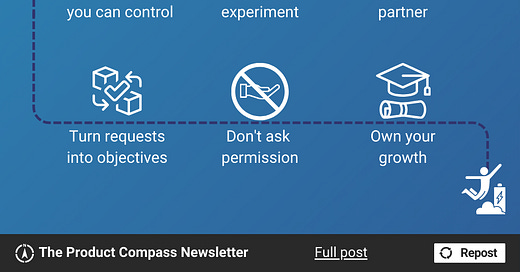Imperfect Product Org Survival Guide
9 proven tactics to overcome challenges, stay sane, and unleash your full potential
Hey, Paweł here. Welcome to the free archived edition of The Product Compass!
Every week, I share actionable insights to boost your PM career.
If you are not a premium subscriber, here’s what you might have recently missed:
You can browse all issues here (Notion): The Best of The Product Compass.
Many of us dream about working in a great product organization. One that echoes the principles we read about in books like Inspired, Empowered, or Continuous Discovery Habits. These titles fuel our passion and paint a picture of a world where teams are empowered, where trust is a foundation, and where people can unlock their true potential.
It’s fantastic to have those dreams.
But let's be real. In my journey, I've found that about 90% of organizations are, at best, mediocre. Teams are hindered rather than empowered, stakeholders’ opinions and customers’ demands replace strategy, and what you do resembles a waterfall process.
You might feel lost.
Sometimes, you might even face the darkness.
It's a complicated place. I've been there many times. It impacted not only my growth but also my mental health at times.
But it's not hopeless.
I've learned that even in the most challenging environments, we can still build, create, innovate, grow, and, most importantly, survive.
Here are 9 proven tactics to overcome challenges, stay sane, and unleash your full potential I’ve been using for the last 9 years.
1. Measure the problem
First off, doing things differently than in books isn’t a problem in itself. There might be valid business reasons for that.
I’d argue that truly empowered product teams are expected to develop a set of unique practices that align with their organizational culture, strategy, and environment.
Arguments like “great companies work differently” or “this is a good practice” are weak. To discuss a problem with others, you must make it tangible.
Consider:
Are your customers happy?
Are your employees motivated?
How fast are you able to deliver value?
Do you make money? Does your product grow?
How fast can you react to changes in the business environment?
For example, instead of talking about solutions, formulate them as problems:
No CI/CD > long release time, high cost or a release, slow rollbacks
12-month feature-based roadmaps > the number of successful initiatives
No product discovery > many unused features, low customer satisfaction
Teams are not cross-functional > implementing simple changes takes ages
How can you measure that? How have those metrics changed over time? Is the pain severe enough for anyone to care?
“The definition of insanity is doing the same thing over and over again, but expecting different results” – Albert Einstein
2. Understand the root cause
As humans, we like to jump into solutions. While in some cases, the problem might be obvious, in others, it's worth spending some time thinking about it in-depth (one technique might be the 5xWhys).
For example, many PMs believe they struggle with developers not being proactive, expecting detailed tasks, and not caring much about the users. In fact, in many of those cases, the root cause is:
The PM reinforces their behavior by providing too-detailed instructions
The PM fails to communicate the strategic context
The lack of psychological safety
Below, I have identified three root-cause areas: cultural problems, harmful processes, and a lack of technology, with example issues:
Remember to frame them as tangible problems for the organization.
3. Ensure transparency
You can't fix most problems alone, but you can make many of them visible. In that case, communicate them openly and warn about future consequences.
Imagine you need access to a system that another team doesn't want to share. I try to avoid politics, but if anything else fails, you might want to list the risks and ask a person with power and influence to make a choice:
Help you solve the problem
Accept those risks
For example, through an email.
In any case, keep communicating risks repeatedly and openly, avoid placing blame, and display your openness to collaboration.
Keep reading with a 7-day free trial
Subscribe to The Product Compass to keep reading this post and get 7 days of free access to the full post archives.





